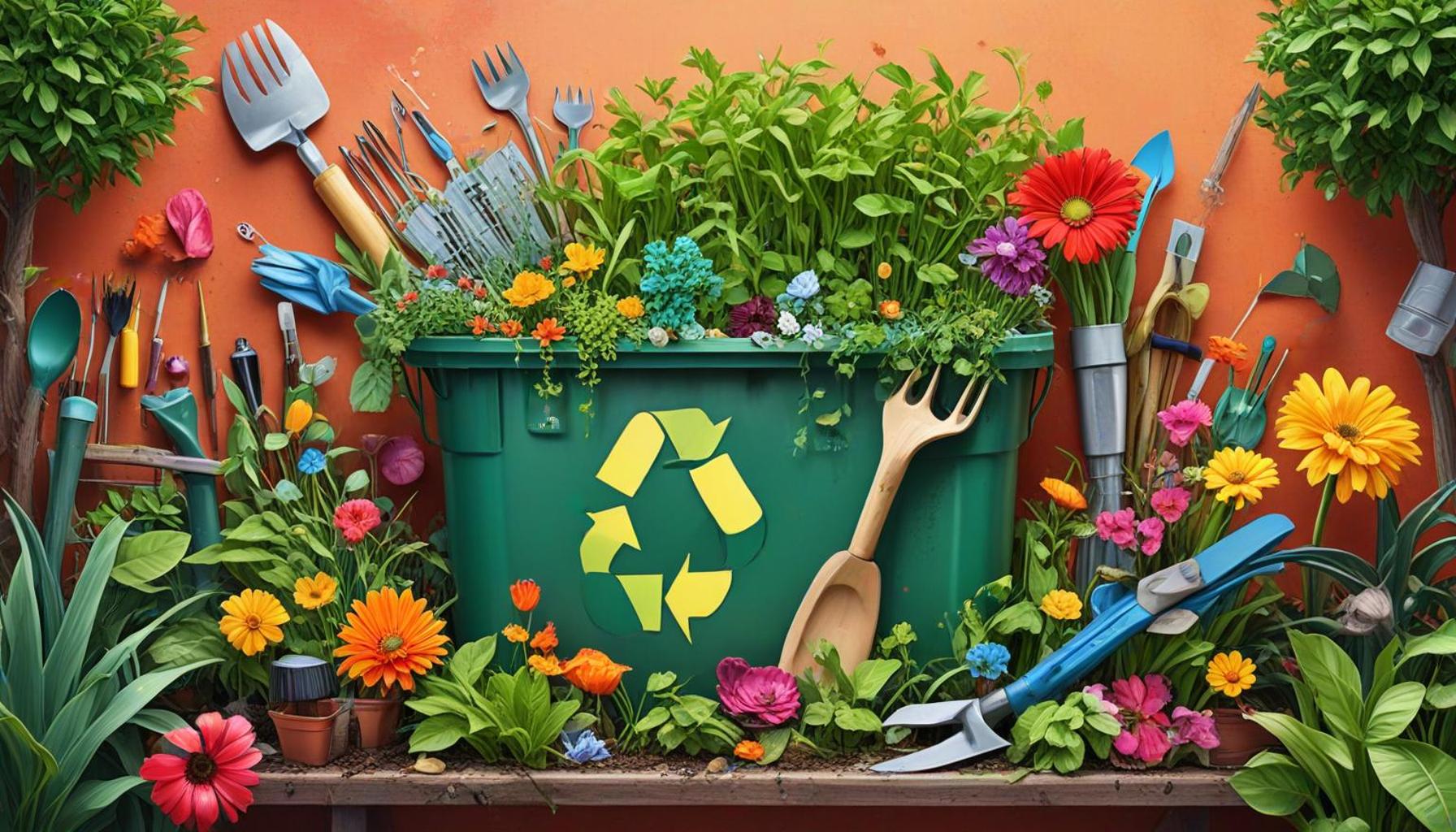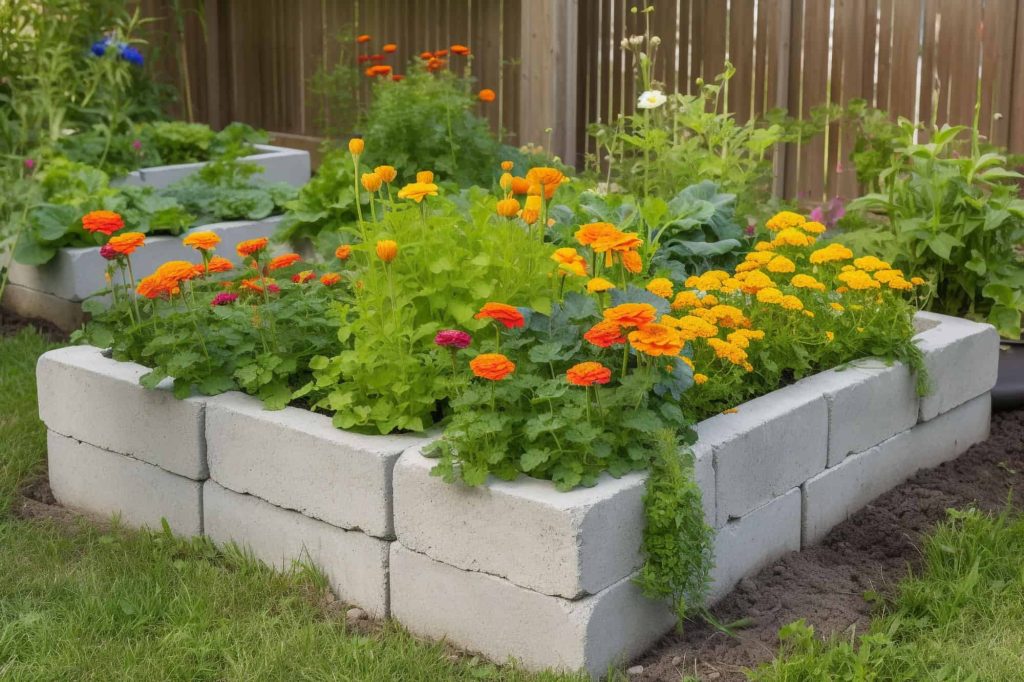Recycling Gardening: Creating Beauty with Sustainable Materials

Understanding the Impact of Recycling Gardening
With environmental issues at the forefront of global discussions, individuals are increasingly seeking ways to contribute positively to the planet. Recycling gardening provides a practical and innovative means to achieve this while simultaneously enhancing garden spaces. By embracing the concept of recycling, this gardening practice allows enthusiasts to cultivate a vibrant ecosystem that not only showcases creativity but also serves a greater purpose by reducing waste.
Key Components of Recycling Gardening
Recycling gardening encompasses a variety of elements that can transform your outdoor space into an eco-friendly haven. Below are some pivotal components that highlight the versatility and creativity involved:
- Upcycled materials: Items such as wooden pallets can be converted into raised garden beds, while old tires can serve as colorful plant containers. Such modifications not only reduce landfill waste but also create unique decorative pieces for your garden.
- Composting: Composting is a crucial practice in recycling gardening. By composting organic kitchen scraps, yard waste, and even coffee grounds, gardeners can produce nutrient-rich soil that supports plant growth, reducing reliance on chemical fertilizers.
- Native plants: Incorporating indigenous flora into your garden design is a wise and sustainable choice. Native plants are adapted to local climates and soil conditions, requiring less water and maintenance, which ultimately benefits both the gardener and the environment.
Innovative Practices in the United States
Across the United States, recycling gardening is capturing the imagination of countless individuals and communities. For instance, urban areas are increasingly turning vacant lots into community gardens that utilize discarded objects creatively. Examples include using glass bottles to create wind chimes, repurposing old furniture as plant stands, or constructing bamboo trellises from fallen branches. These gardens not only beautify neighborhoods but also reach out to local residents, fostering community spirit and environmental awareness.
As you embark on your own recycling gardening journey, think about how combining functionality with artistry can inspire those around you. Share your experiences, techniques, and discoveries with fellow gardeners, and encourage them to explore sustainable practices. Through collaboration and shared ideas, recycling gardening can grow into a widespread movement that promotes sustainability and beauty in every corner of our communities.
With more cities launching green initiatives and workshops, there has never been a better time to engage in recycling gardening. Not only can you cultivate a garden emblematic of your personal style, but you can also contribute to a more sustainable future. Dive into the world of upcycling and watch as your garden transforms into a vibrant eco-system that is both aesthetically pleasing and responsible.

DISCOVER MORE: Click here to delve deeper
Creative Techniques for Recycling Gardening
In the realm of recycling gardening, creativity plays a pivotal role in transforming everyday materials into beautiful and functional garden elements. By discovering innovative techniques that incorporate both aesthetics and sustainability, gardeners can reimagine their outdoor spaces while contributing to a greener planet. Below, we delve into some of the most effective and imaginative ways to put recycling concepts into practice.
Repurposing Household Items
One of the most exciting aspects of recycling gardening is repurposing items typically found around the home. Instead of discarding these belongings, gardeners can breathe new life into them, effectively blending practicality with artistic expression. Consider the following ideas:
- Glass Jars and Bottles: From mason jars to empty wine bottles, glass containers can become vibrant plant holders or charming lanterns. Painting or decorating these items allows for unique designs tailored to the gardener’s taste.
- Old Furniture: Think about using an old dresser or a chair as an unconventional planter. The compartments of a vintage dresser can accommodate various plants and herbs, while a discarded chair makes for an eye-catching focal point when outfitted with flower pots.
- Wooden Crates: Wooden crates can be creatively stacked to form raised beds, providing both display space and easy access for gardening. They can also serve as beautifully rustic storage units for garden tools and supplies.
The Role of Pallet Gardening
Pallet gardening has emerged as a popular trend within the recycling gardening community. These versatile wooden structures can be transformed into vertical gardens, saving space while maximizing planting opportunities. Gardeners can create stunning displays using a variety of plants, including herbs, flowers, and vegetables. Here’s how to get started:
1. Obtain a wooden pallet and ensure it is free of chemicals, such as those often found in treated wood. Look for pallets labeled as “HT” (heat-treated).
2. Lay the pallet on its back and reinforce with landscaping fabric to hold soil while allowing for drainage.
3. Fill the pallet with soil and suitable plants, leaning towards those with shallow root systems.
This technique not only promotes vertical gardening and space efficiency but also resists soil erosion, making it an excellent choice for urban gardeners with limited ground space.
Benefits of Involving the Community
Engaging your neighborhood in recycling gardening initiatives can significantly boost local environmental awareness and foster connections among residents. Participating in community workshops or creating a communal garden project, where individuals bring their unique recycling ideas to the table, can inspire creativity and collaboration. Additionally, this shared effort to practice sustainability emphasizes the importance of collective responsibility and support for eco-friendly practices.
The journey of recycling gardening provides an opportunity for individuals to not only beautify their surroundings but also to embrace a more conscious approach to waste management. With the right techniques and community engagement, the possibilities are endless, paving the way for a more sustainable future for all.
| Advantage | Description |
|---|---|
| Sustainable Resource Utilization | Recycling gardening utilizes sustainable materials such as reclaimed wood, old bricks, and natural compost, significantly reducing waste and promoting a greener environment. |
| Cost-Effectiveness | By repurposing discarded items for garden projects, enthusiasts can save money while creating unique and beautiful outdoor spaces. |
Recycling gardening not only enhances the visual appeal of landscapes but also fosters a culture of sustainability. Through the careful selection of materials like old tires and glass bottles, gardeners can create striking decorative elements that speak volumes about environmental stewardship. The reduction of landfill contributions is another significant benefit, making it an increasingly popular choice for eco-conscious homeowners.Moreover, embracing recycled materials allows for creativity to flourish. From garden sculptures to functional items such as compost bins, the potential for exquisite designs is limitless. This practice harmonizes the beauty of nature with the necessity of sustainable living, inviting individuals to reflect on the importance of protecting our planet while enjoying its bounties. How can one resist the charm of a lush garden that tells a story of renewal and care for the Earth?
DIVE DEEPER: Click here to unlock your creativity
Innovative Materials for Sustainable Gardening
In the quest for recycling gardening, exploring innovative materials can lead to delightful surprises and practical solutions. By utilizing sustainable and reclaimed items, gardeners can reduce waste while enhancing their landscapes. Here, we showcase some unexpected yet effective materials that can transform your green space into a sustainable haven.
Transforming Food Scraps
Food scraps, often dismissed as waste, hold immense potential for gardening enthusiasts. Coffee grounds, eggshells, and fruit peels can rejuvenate the soil and nourish plants, thereby minimizing landfill contributions. Consider these methods of utilizing food waste:
- Coffee Grounds: Rich in nitrogen, coffee grounds can be sprinkled directly on garden beds. They improve soil structure and attract beneficial earthworms, which aerate the soil.
- Eggshells: Crushed eggshells provide a natural source of calcium, essential for healthy plant growth. They can be mixed into the soil or sprinkled around the base of seedlings to deter pests.
- Fruit and Vegetable Scraps: Composting these scraps not only diverts waste but enriches your soil with organic matter. Create a compost pile or use a compost bin to facilitate decomposition and produce nutrient-rich compost.
Utilizing Reclaimed Wood
Reclaimed wood, sourced from old pallets, barn doors, or dilapidated furniture, presents an eco-friendly option for creating stunning garden features. Here are a few ways to bring reclaimed wood into your gardening repertoire:
- Raised Garden Beds: Build raised garden beds from reclaimed wood to establish a growing area that prevents soil compaction and improves drainage. The rustic aesthetics add a timeless charm to any garden.
- Garden Paths: Old wooden planks can be repurposed into charming pathways, offering both functionality and character to the landscape. Surprisingly, these paths can help define spaces within the garden.
- Birdhouses and Insect Hotels: Crafting birdhouses and insect hotels from leftover wood encourages biodiversity, providing essential habitats for local wildlife while enlivening your outdoor space.
Using Recycled Fabrics and Textiles
Textiles, often overlooked, can offer creative options for gardening while supporting waste reduction efforts. By upcycling old clothes or fabric scraps, you can craft various garden items. Consider the following:
- Plant Holders: Transform old T-shirts or towels into unique planter bags by cutting and sewing them into shapes that can hold soil and plants. This approach allows you to add color and texture to your garden.
- Weed Barriers: Old carpets or fabric can serve as effective weed barriers when laid down before planting. These materials suppress weed growth while allowing water and nutrients to permeate the soil.
- Rope and Twine from Recycled Fabrics: Create biodegradable ties for plants and seedlings using repurposed fabric scraps. Not only does this reduce waste, but it also blends seamlessly into the natural landscape.
Exploring these innovative materials within the scope of recycling gardening highlights the beauty of sustainability. With each new project, gardeners not only create pleasing visuals but also champion environmentally-friendly practices that can inspire others to join in on the green movement. The transition from waste to resource fosters a sense of community spirit and a deeper connection to the earth, ensuring a thriving future for our gardens.
DISCOVER MORE: Click here for creative solutions
Conclusion
In conclusion, recycling gardening not only enriches our gardens but also nurtures our planet. By creatively repurposing materials typically seen as waste, such as food scraps, reclaimed wood, and textiles, gardeners can significantly decrease their ecological footprint while cultivating vibrant outdoor spaces. The journey of transforming these unconventional resources into stunning garden features not only offers aesthetic appeal but emphasizes our responsibility to foster sustainability in our everyday practices.
Engaging in this eco-friendly approach encourages a greater appreciation for nature and our role within it. As you explore the world of recycling gardening, consider how each project can inspire others to rethink waste and adopt sustainable practices. From enhancing soil health with kitchen scraps to creating charming pathways from reclaimed wood, the possibilities are endless. Moreover, these actions reflect a commitment to protecting our environment for future generations.
As more individuals embrace sustainable gardening techniques, we move closer to a collective goal of reducing waste and promoting biodiversity. By sharing your successes and innovative ideas, you can become a catalyst in your community, inviting others to join this rewarding movement. Ultimately, recycling gardening transforms not just landscapes but mindsets—motivating us to see beauty in sustainability and fostering a deeper connection with the earth.
Related posts:
Color Gardening: Creating Vibrant Palettes with Plants and Flowers
Fairy Tale Gardening: Creating Magical Spaces with Fantasy Elements
Seasonal Gardening: Creating Gardens that Celebrate the Colors and Textures of Each Time of Year
Transforming Small Spaces: Creative Ideas for Gardens on Balconies and Terraces
DIY Herb Gardens Customize Your Green Space with Style
Transforming Small Spaces: Creative Ideas for Urban Gardens

Linda Carter is a writer and creative hobbies expert specializing in crafting, DIY projects, and artistic exploration. With extensive experience helping individuals discover their creative potential and bring their ideas to life, Linda shares her knowledge on our platform. Her goal is to empower readers with practical tips, inspiring ideas, and step-by-step strategies for success in the world of creative hobbies.